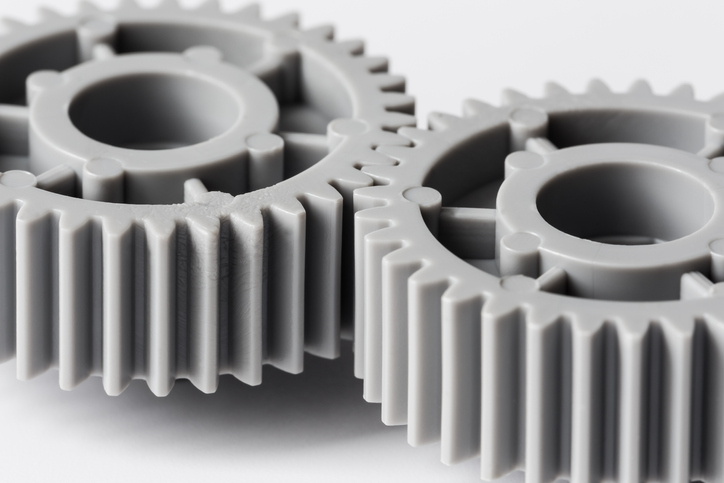When it comes to manufacturing high-performance plastic parts, several things have an impact on quality and functionality — think things like process parameters, material selection, and industry expertise. But one of the most essential things to get right is the mold design. With an expertly engineered injection mold design, manufacturers are better able to meet strict tolerances, maintain dimensional accuracy, and ensure part performance. How, exactly? Let’s take a look at five essential tips for injection mold design that will help you create parts that not only meet but exceed performance expectations.
Tip 1: Prioritize Material Compatibility in Injection Mold Design
When conceptualizing and designing high-performance components, material selection is one of the most important factors that manufacturers must consider. The same can be said for injection mold design. High-performance polymers like PEEK are known for their exceptional thermal and mechanical properties. But the flipside of this advantage is that they require higher processing temperatures and pressures than standard plastics — which means the material of the injection mold design itself must also be able to perform under these conditions.
And on top of that, the mold material must be able to withstand those conditions without degrading over time. If a manufacturer makes a poor choice for the material of the injection mold design, it could result in premature wear, corrosion, or even permanent damage, all of which can lead to unplanned downtime and higher production costs. To further combat this, high-temperature alloys, hardened steel, and specialized coatings are often required to maintain the mold’s durability and ensure a smooth surface finish for the molded parts. Additionally, selecting the right surface finish helps optimize material flow and prevents issues like sticking or warping.
Tip 2: Optimize Gate and Runner Design for High-Performance Parts
During injection molding, how the molten polymer flows into the mold cavity directly influences part consistency, structural integrity, and defect minimization. That’s why gates and runners are pivotal to the injection mold design. Proper gate and runner design help ensure that the polymer fills the mold evenly and efficiently, which is particularly important for complex, high-tolerance parts.
The choice between hot runners and cold runners is also essential when working with high-performance polymers like PEEK. Hot runners, for instance, allow for more precise control over material flow, reducing waste and enabling faster cycle times. Cold runners, on the other hand, may be better suited for simpler part designs.
And when it comes to the gates, location and size are everything; well-placed gates can help manufacturers avoid issues like sink marks, voids, and incomplete fills. By optimizing both gate and runner design, manufacturers can enhance part quality, reduce defects, and improve material flow for more efficient and reliable production outcomes.
Tip 3: Precision Cooling Channel Placement for High-Tolerance Parts
Another essential element of injection mold design is the cooling system, which plays a critical role in determining both the quality of the components and the efficiency of the production process. Especially in the case of high-tolerance parts made from advanced polymers, precise control over the cooling phase is essential to avoid issues like warping, shrinkage, or internal stresses. If cooling is uneven or too rapid, it can result in dimensional inaccuracies or parts with compromised mechanical properties.
One way that manufacturers ensure uniform cooling is by using conformal cooling channels. These differ from traditional straight channels in that they follow the complex contours of the mold; this results in more consistent temperature regulation across the entire part. This element of injection mold design is particularly beneficial for high-performance thermoplastics like PEEK, which require high heat during molding but gradual and controlled cooling to maintain dimensional accuracy.
Effective placement of cooling channels not only reduces the risk of defects but also shortens cycle times and enables faster production without sacrificing precision.
Tip 4: Optimize Injection Mold Design Features to Handle Shrinkage and Warpage
Shrinkage and warping are common concerns when working with high-performance polymers. To address these issues, the injection mold design must incorporate specific design features that anticipate and manage shrinkage during the cooling phase.
Ribbing, for example, is a feature that helps reinforce areas prone to warpage which can reduce the chances of deformation. Similarly, incorporating draft angles and ejector pins can help ensure an easy ejection of the completed part, reducing the risk of damage. All of these features work together to allow for more predictable shrinkage behavior to ensure the final part meets specifications.
Tip 5: Ensure Mold Durability and Longevity for High-Performance Materials
And finally, it’s vital that the injection mold design accounts for the stresses that will be placed on it throughout the injection molding process. As we’ve established, these pressures can be significantly greater when working with high-performance plastics.
In order to achieve the necessary durability, manufacturers sometimes turn to hardened steel for mold cavities, which can withstand the wear and tear associated with processing high-performance polymers. Specialized coatings can further enhance the mold’s resistance to high temperatures and reduce friction, extending the lifespan of the mold.
Investing in robust injection mold design doesn’t just ensure longevity — it also maintains consistent part quality throughout high-volume production. By prioritizing mold durability, manufacturers can minimize downtime, reduce costs associated with repairs and replacements, and provide a more efficient and reliable production process.
Ensinger Specializes in High-Performance Plastic Part Production
At Ensinger, our speciality lies in high-performance injection molding and we’re well-versed in the science of an optimized injection mold design. In business since 1934, we provide plastic manufacturing services to a wide range of critical industries. Alongside our extensive injection molding capabilities, we also offer CNC plastic machining, post-molding services, and design and engineering assistance, amongst others.
Get in touch with us today to explore how we can support your projects.
